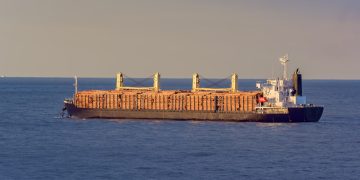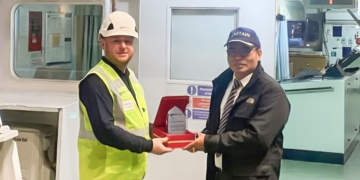On 7 February 2021, the Danish-flagged container ship SANTA CLARA was about to berth in the Port of Bremerhaven when an OS fell overboard while rigging the gangway. Despite extensive searches, she was never found and presumed dead. DMAIB issued an investigation report on the incident.
The incident
At 0245, the day man was woken by a call from the 2nd officer who told him to be on standby at 0330 by the pilot ladder and prepare for bringing the Bremerhaven port pilot onboard. The day man called an able seaman (AB), an ordinary seaman (OS), and the deck cadet and told them to prepare the accommodation ladder. Ten minutes later, they met in the locker room and donned their working clothes and personal protective equipment. It was a cold and windy morning, with a strong breeze and an air temperature of -5°C
Once on deck, the OS and the deck cadet started to remove the hook bolts that secured the accommodation ladder. Meanwhile, the AB went to the port side of the ship to don a safety harness and pick up a fall arrester to be used when he went outboard to rig the accommodation ladder’s handrails and platform.
[smlsubform prepend=”GET THE SAFETY4SEA IN YOUR INBOX!” showname=false emailtxt=”” emailholder=”Enter your email address” showsubmit=true submittxt=”Submit” jsthanks=false thankyou=”Thank you for subscribing to our mailing list”]
When the AB came back, the hook bolts had been removed, and the accommodation ladder was ready to be lowered. The AB told the deck cadet to go to the control station and lower the accommodation ladder. By the control station, the deck cadet pressed the button for lowering the accommodation ladder. But even though the fall wire holding the accommodation ladder in place paid out, the ladder did not lower. It was stuck. The deck cadet called out to the AB that something was wrong.
After the AB had made several attempts to lower the accommodation ladder, the AB concluded that the accommodation ladder was somehow stuck, and that the fall wire had become slack. The AB was worried that the slack fall wire would become entangled on the winch, so he went to clear up the slack fall wire on the winch by hand.
Afterward, he went to the forward part of the accommodation ladder to see if he could identify the problem. As he walked forward, the OS went to the winch and held the slack wire. Suddenly, the accommodation ladder was released, fell down, and the wire was tightened instantly. From the control station, the deck cadet saw the OS being forcefully hurled overboard. The deck cadet immediately shouted “man overboard!”, and the AB turned around and saw that the OS was missing. The time was 0339.
Despite an extensive search, the rescue services did not succeed in finding the OS. Only the lifebuoys, thrown overboard from SANTA CLARA, were found. The search operation was concluded in the late afternoon on 7 February at 1709.
Findings
The witness testimonies suggested that the sudden release of the accommodation ladder was closely related to the OS being thrust overboard. However, this does not in or of itself explain why the OS was thrust overboard. There were other circumstantial factors that explicate why none of the crewmembers recognized the hazards of untangling the fall wire under the given circumstances.
Once the accommodation ladder system malfunctioned, the crewmembers found themselves in a unique situation, and there was thus no procedure or risk assessment to turn to.
None of the three crewmembers had any experience in neither fault finding nor manual operation of the accommodation ladder, because the automated lowering system did usually not require any manual intervention. This led them to improvise to understand and solve the problem at hand,
…the report reads.
The AB did not report the malfunction to the bridge, because he was still in the early stages of fault finding and suspected that the problem could be immediately solved.
Meanwhile, the OS tried to avoid additional problems by apparently keeping the fall wire untangled on the winch which was a known problem for the crewmembers, and one they knew how to solve.
None of the crewmembers had reason to think that the malfunction of the accommodation ladder would resolve itself spontaneously causing it to be released.
This accident was thereby the result of a partly automated system that performed in an unexpected way, and the crew did not have the experience or system knowledge to immediately recognize the hazard it entailed when solving the immediate problem of the entangled wire.
The result was that the force of the falling accommodation ladder was transferred to the wire and the OS, forcing her overboard. There was no railing mounted on the ship’s side by the winch, which meant that only the winch stood between the OS and the edge of the upper deck. She fell 17 meters into the sea which had a temperature of 2°C. Under those circumstances, the OS’s survivability was time-critical.
In addition, the ship’s emergency planning, drills and exercises were based on the condition that the ship was in open waters which hindered an effective shipboard response to the situation, because the ship was manoeuvering in the confined waters of river Weser. Once the master realized that the shipboard emergency contingency measures were not designed to enable them to respond to the given situation, it became a matter for the coastal authorities to locate and retrieve the OS.
Actions taken
DMAIB received information that the company has initiated the following preventive actions as a response to the accident:
- The accommodation ladder installation on the Santa Class has been assessed resulting in extension of the railing design. Modification has been initiated for the vessel class (10 vessels in total).
- Decision has been taken to upgrade the onboard personal protective equipment.
- Inflatable life jackets will be applied with personal locator (AIS) beacons.
- Test of light immersion suits for cold areas has been initiated and will be implemented for use in cold areas while working with high risk of falling overboard e.g. when preparing the accommodation ladder.
- Emergency Flowchart (P822) for Man Overboard / Search & Rescue will undergo a review
- PMS activity for gangway check being reviewed – ensuring free movement of gangway.


































































There are instances that Gangways have a tendency not to respond immediately when being lowered from stow position, at times it needs a little bit of persuasion when this anomaly happens. A forceful kick or push on the swivel plate of the gangway most of the time does the trick. There is no complicated solution to a problem like this and the AB should know this method as with any experienced AB. It defies logic to hear that the victim was thrusted overboard as you squarely put it but I BEG TO DISAGREE that this is the case, because a normal human reaction to a sudden jerk of the gangway whose weight could be somewhere in the order of 3 tons more or less and the rapid un spooling of the fall wires from the winch would be to let go of it lest the person consciously wishes to injure his/her hand by not letting go. This investigation report is a product of a tall story told by the crew who were briefed by their company to coverup the true event that happened. In the first place, why didn’t the crew put on a life vest which is an industry standard when rigging gangways or pilot ladders especially when the ship is underway? Is this not part of the Safety Management System safety procedures of Maersk? Whatever happened to their safety culture? Has this become a mere footnote now? There is an element of negligence here and somebody is not telling the truth. Had they strictly enforced this basic requirement, there was no reason for them not to find the victim’s body, dead or alive! The absence of a life vest in carrying out this critical task is at the heart of not finding the victim with any degree of success. I hope the investigator who carried out this investigation had exercised due diligence in gathering facts and establishing the truth and not just satisfied with the sanitized accounts of the Master and crew as portrayed in this report. This is the second incident of a crew member being lost due to falling over board at sea in the fleet of Maersk Line. Is their Safety Management System even working at all? If so why are these accidents still happening? I am just interested what their SMS means to them. Please look into this aspect also to verify the degree of their compliance to the requirement of the ISM particularly their Safety Management System. A revocation of their SMC would be in order if negligence and cover up is ever proven. A life is lost and this report only reflects the stories fabricated by the ship’s crew. How can we believe this report when it is anchored based on the stories of the very people who are afraid to lose their jobs for telling the truth? Please do not allow your reputation to be ruined by people or institutions who are not telling the TRUTH! Thank you!